Warren Haynes. Keith Urban. Brad Paisley. Mark Knopfler. Billy Gibbons. Though these guitarists all have unique signature tones, they've all used Trainwreck amplifiers in the studio and on the stage.
Designed and hand–built by the late Ken Fischer in a basement in Colonia, New Jersey, Trainwrecks have developed legendary status across the music industry for their sparkling clean tones, dynamic touch response, and harmonically rich overdrive.
For an amplifier series that is reputed to approach the “holy grail” of tone, Trainwrecks are surprisingly basic designs: single channel heads devoid of reverb or effects loops. Ken Fischer’s circuits are so simple, in fact, that just about any amateur amp builder can make one.
Unfortunately, the final product won’t sound like a real Trainwreck. The key to the these iconic amps rests in the ears, intuition, and craftsmanship that Ken Fischer had himself.
Who Was Ken Fischer?
If anyone could fit the description of a tube amp guru, it would be Ken Fischer.
Fischer was surrounded by electronics almost his entire life. He started off tinkering in his neighbor’s workshop as a child, went on to work as a TV repairman after his military service, and ended up designing amplifiers for Ampeg.
By his own account, he also had a passion for girls, guitars, and motorcycles, although he complained that only the latter two came with instruction manuals.
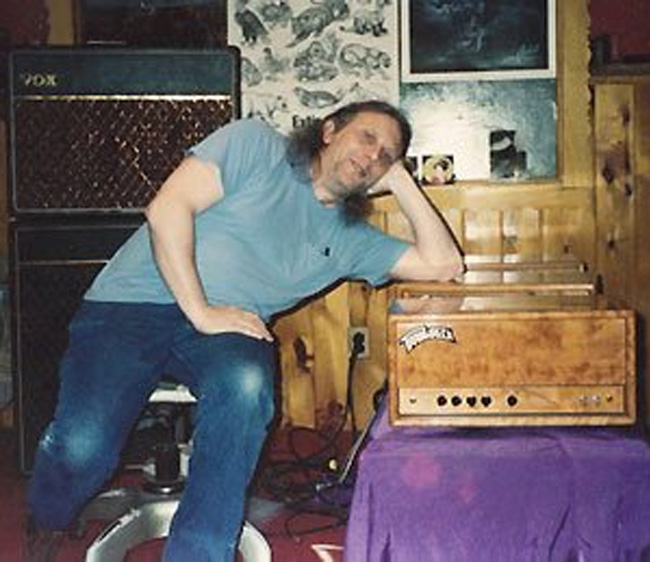
Ken Fischer
Fischer quit Ampeg when the company was sold in 1980. He didn’t want to work for an amp company that would no longer be under the control of musicians.
Fischer had been informally repairing amps for friends in the preceding years, but now his underground amp business would become his main source of income. By 1982, he was soon making enough money that he needed to incorporate.
Fischer’s nickname among his biker buddies was “Trainwreck,” so he chose to call his repair business Trainwreck Circuits.
Many of Trainwreck Circuit’s clients wanted Fischer to modify their amplifiers. Instead of performing standard “mods” for his clients, Fischer would attempt to give every amplifier that came into his hands the best sound possible, which often meant making a custom modification for each one.
Approaching each amp as a unique sonic instrument — regardless of similarities in brand, circuitry, or components — was the foundational philosophy of Trainwreck Circuits.
How Wizardry and Simplicity Combine to Create Tone
If your bandmate’s Trainwreck clone sounds underwhelming, it’s because it’s built like any other amplifier: electrical components blindly soldered together in a prespecified configuration.
But for Ken Fischer, the amp’s circuit design in the strict sense was the least important aspect of making an amp sound good. In fact, he thought that improvisation was the engineer’s most valuable tool in building a good amp.
And, famously, Fischer had some outlandish beliefs that fueled his amp designs.
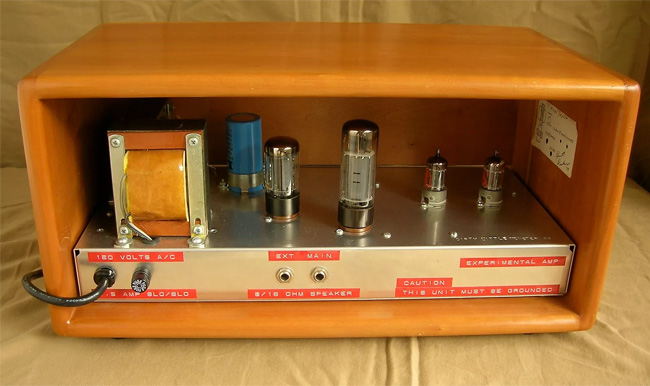
Trainwreck Dirty Little Monster 1999
Fischer would use only aluminum chassis because he believed that steel would interfere with the magnetic field of the output transformer and negatively affect the amp’s overall tone. His concern with magnetic fields was such that Fischer spent an inordinate amount of time working on the layout of his circuit within the amplifier chassis.
In a far cry from today’s printed circuit boards, Fischer would individually solder all of the components, trying different three dimensional layouts until the amp sounded like what he (or his client) wanted.
Fischer also used solid core wiring because he believed that braided wires create phasing issues between the input and output signals of the amp.
This concern was linked to another, potentially questionable, principle: making sure the input signal and output signal were in phase would optimize the amp’s response, harmonics, and feedback. Most guitar amplifier designers, for example, do not address phase distortion between the input and output signals as long as the phenomenon isn’t severe.
Less controversial were Ken Fischer’s attention to precise soldering and careful selection of components. He only used silver mica caps, precision resistors, and ceramic sockets for the tubes that he matched by hand.
Fischer believed that he could hear and feel the minute differences between components of the same make and model and would take this into account in the layout of his circuits.
To top it off, Ken Fischer reportedly used transformers that he built himself according to secret specifications.
Many amplifier experts might disagree with some (or all) of Ken Fischer’s beliefs and dismiss his practices as mere superstition. Skepticism does hold water, as it’s extremely difficult to prove some of Ken Fischer’s claims.
But regardless of empirical validity, Fischer’s practical end result was undeniable. Trainwreck amplifiers sound amazing and feel more responsive than the average tube amp.
Ken Fischer’s Trainwreck Line-Up Emerges
Ken Fischer’s amp modifications became so well regarded that by the early '80s, guitarists from all over the globe were visiting his small basement in New Jersey to optimize their tones.
In 1982, a client from England who relied on Mesa Boogies and Vox AC30s asked Fischer to build him an amp from the ground up.
The end result was a classically British Class–A–sounding amp with three ECC83s (12AX7s) in the preamp and four EL84s in the power stage. Since the client had played in the Beatlemania tribute band and Fischer’s design had British roots, which said the client claims inspired Fischer to call the new design the Liverpool 30.
Word soon got around about the Liverpool, and Fischer found himself facing more orders than he could handle. At the time, his repair and modifications businesses were far more profitable than building amplifiers.
In turn, the production of what would become some of the most iconic amplifiers ever built was relegated to a side project. He felt that he was doing favors for friends, so he didn’t give his amps serial numbers. Instead, he gave them nicknames to “keep it on a personal level.”
By 1984, Ken Fischer had designed the Trainwreck Express. This new design was born out of a collaboration with a client who was constantly seeking modifications for his Marshall Plexis.
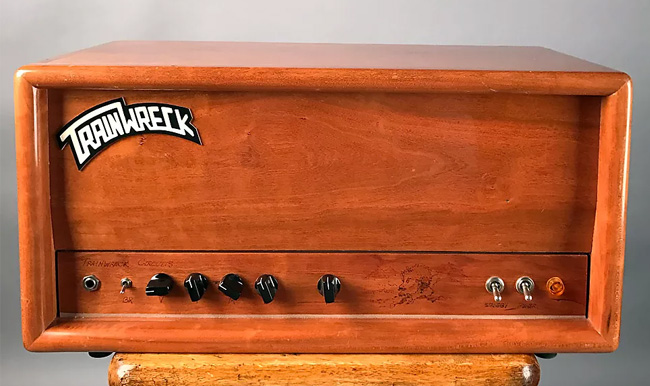
Trainwreck Express 1990
Fischer was tasked with modding a Marshall 1959 Super Lead to closer emulate Eddie Van Halen’s tone. He tweaked the Plexi’s preamp circuit to drastically increase the gain and harmonics, but the amp was then far too loud for of practical use.
To make the amp quieter, Fischer reduced the output by switching out the four EL34 tubes for 6V6s. The client preferred the EL34 tone, however, so Fischer decided to reduce the output stage to two EL34s. By this point, the amp became its own animal.
Like the Liverpool 30, the Express retained three ECC83s in the preamp. The output stage could run on either EL34s or 6V6s, allowing for a variable output of 36 to 22 watts.
Just like the Liverpool 30, the Express quickly gained a following. As orders poured in — many from the preeminent guitarists — Fischer finally dedicated his entire business to manufacturing and servicing of his own designs.
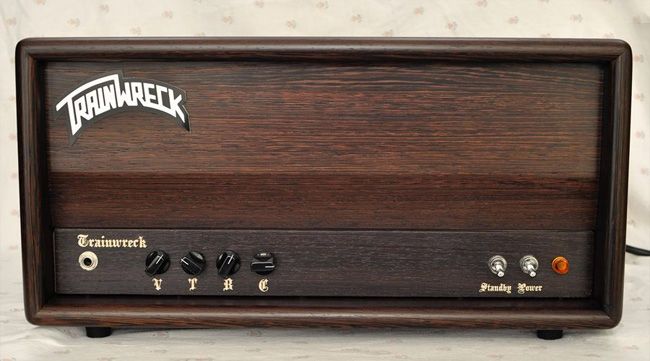
Trainwreck Rocket
Unfortunately, just as his popularity was peaking, Ken Fischer came down with a bad case of the flu in 1988. He never fully recovered, and was eventually diagnosed with bleeding ulcers and chronic fatigue immune dysfunction syndrome. When he felt up to it, Fischer would build an amp for one of the many guitarists on Trainwreck’s waiting list.
He also continued to experiment. One client who visited the Trainwreck shop in 1990 noticed an amplifier on Fischer’s bench with four knobs instead of five. This became the Rocket, which was essentially a tweaked AC30 circuit complete with a three ECC83 preamp and four EL84 output stage.
The client loved this lower–gain amp so much that he convinced Fischer to build another one. The ailing Fischer now found himself facing demand for three of his own original designs.
The Trainwreck in Practice
Improvisation was the guiding principle behind a Trainwreck’s design, and instability was the goal. Ken Fischer designed his amplifiers (with the exception of the Rocket) to run at exceptionally high gain levels, bordering on oscillation.
He would talk about the design of the F16, a highly maneuverable aircraft whose performance relied on its design’s instability. “When you start getting complex harmonics, that’s what you need to make an amp sound complex. The more stable an amp becomes, the less complex it is.”
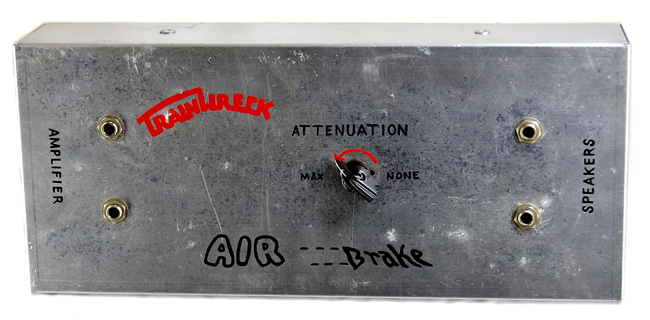
Trainwreck Air Brake Attenuator
Trainwrecks are single channel amplifiers, so there is no “crunch” button you can press to activate clipping. Instead, you simply turn the volume knob of the amp up until you reach the desired level of distortion. Unless you use an attenuator, you cannot get a distorted tone out of a Trainwreck at low volumes.
Fortunately, the amps sound great in their clean range, producing a classic, chimey, Fender–like tone. You can access the clean tone when the amp is in its distorted range by turning down the volume knob on your guitar.
When you push a Trainwreck’s volume knob past ten to twelve o’clock, the amp won’t get any louder, it will just get dirtier sustain longer. This is not hollow, high–gain ‘80s distortion.
Trainwrecks produce a rich and layered sound where crunchy mids combine with screaming highs and overtones multiply the longer you allow a note to sustain. Somewhere between the clean and hard rock distortion zones is an excellent, progressively overdriven sound that is perfect for blues, country, classic rock.
When you start getting complex harmonics, that’s what you need to make an amp sound complex. The more stable an amp becomes, the less complex it is." - Ken Fischer
In addition to the complex and lively harmonics, Trainwreck amplifiers are incredibly responsive to the player’s touch.
The amount of distortion you get varies significantly depending on how you attack the string, so the amp accurately conveys the dynamics of your performance. The amp also has a very fast response to the player’s picking, which again enables the amplifier to capture every nuance of your playing.
Trainwrecks are therefore not great for beginners or for players with a loose right hand technique. The amp’s fast response and tendency to generate harmonics from each note you play will highlight every unintended note.
Another reason why these amplifiers might not agree with some players is that, with the exception of the Rocket, they do not take effect or boost pedals particularly well. But then again, the point of a Trainwreck is to have a self–contained tone machine in the mold of the old greats, not a pedal platform.
Are Trainwreck Clones and Offspring Worth a Shot?
Even before Ken Fischer’s death in 2006, it was virtually impossible to get your hands on a Trainwreck. The waiting list was years long, as Fischer’s declining health made the production of amplifiers an insurmountable task.
Now, an original Trainwreck amp will appear on the used market every once in awhile, only to be snatched up a wealthy performer or collector. The high demand for these amps has pushed prices into the tens of thousands of dollars.
Luckily for tone aficionados of more humble means, there are plenty of ways to get into the ballpark of Trainwreck amps at a fraction of the cost of the real deal.
Komet 60
Designed by Ken Fischer and hand–built in the United States, the Komet 60 includes a high–cut control and allows the user to select the amp’s response speed. With two EL34s in the power stage, the amp is most often compared to Marshall Plexis, but some users report it has a Vox–like chime.
Z Wreck
This Liverpool–style, EL84 powered amp was originally a one–off collaboration between Dr. Z, Ken Fischer, and Brad Paisley, but it is now offered to the public. The amp uses output transformers designed by Ken Fischer himself. Like the Komet, the Z Wreck allows the user to alter the amp’s response between “comfort” and “speed.”
Ceriatone Expression
Based in South East Asia, Ceriatone produces clones of the Trainwreck Express, Rocket, and Liverpool. Compared to other clones, the Ceriatones are relatively inexpensive and are available in a kit or assembled.
Fuchs Train 45
Also known for their Dumble clones, Fuchs has produced a highly regarded Trainwreck Express inspired amp. Nonetheless, the amp makes a significant departure from original Trainwrecks: it uses a printed circuit board as opposed to the point to point construction that Fischer preferred.
Two Rock Ruby
If you want a Trainwreck Express clone that includes an effects loop and a master volume, Two Rock's version may be the amp for you. Unfortunately, these amps are hard to come by, as they were made by hand in small numbers.
Trainwreck Reissue
In the last few years, an amp builder who goes by the initials JM has taken over Ken Fischer’s workshop, and with the approval of Fischer’s family and access to all of his technical data, has begun building Trainwrecks under the brand's original name. JM’s customers seem to love the new Trainwrecks, which, like their predecessors, come at a hefty price.
Homemade clone
Since Trainwreck circuits are so simple, many people build them at home. Though this is the most cost effective way of getting close to Ken Fischer’s tone, it's also the riskiest. An amateur might be able build a Trainwreck, but only someone with good ears and lots of amp building experience will be able to make them sound good.
A quick perusal of online Trainwreck forums will lead you to some of the more reputable clone builders.
